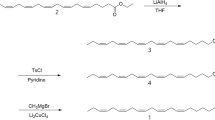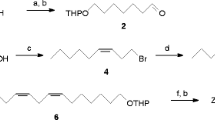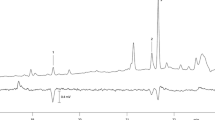Abstract
The native leafmining moth Tischeria ekebladella (Lepidoptera: Tischeriidae) feeds on oaks and recently has become a pest of silviculture and urban green areas in central Europe. The behavioral responses of male moths to hexane extracts of whole bodies of calling females or males were tested under laboratory conditions. Only extracts of females elicited responses from males. Analysis of extracts by coupled gas chromatography/electroantennographic detection revealed the presence of two electroantennogram-active peaks. Structure elucidation of these compounds, by gas-chromatography/mass spectrometry and independent synthesis revealed them to be (3Z,6Z,9Z)-tricosa-3,6,9-triene and (3Z,6Z,9Z,19Z)-tricosa-3,6,9,19-tetraene. While the triene was present in both sexes, the tetraene was female-specific. The latter is a new structure for a pheromone component of Lepidoptera and a novel natural product. Field trapping tests, carried out in a mixed oak forest near Budapest (Hungary), using synthetic compounds applied to rubber dispensers, showed that the tetraene per se elicited catches of males in large numbers. When the triene was added to the tetraene in a ratio of 1:1, there was no increase in trap catch; the triene alone did not elicit catches of males. For monitoring this insect, the tetraene, applied to rubber dispensers at a dose of 300 μg, is a potent sex attractant.



Similar content being viewed by others
References
Ando, T., Inomata., S., and Yamamoto, M. 2004. Lepidopteran sex pheromones, pp. 51–96, in S. Schulz (ed.) The Chemistry of Pheromones and Other Semiochemicals I: Topics in Current Chemistry 239: 51–96, Springer, Berlin, Heidelberg, New York.
Attygalle, A. B. 1998. Microchemical techniques, pp. 207–294, in J. G. Millar and K. Haynes (eds.), Methods in Chemical Ecology, vol. 1. Chapman & Hall, New York.
Beadle, G. W. and Ephrussi, B. 1936. A technique of transplantation for Drosophila. Am. Nat. 70:218–225.
Bell, T. W. and Meinwald, J. 1986. Pheromones of two arctiid moths (Creatonotus transiens and C. gangis): chiral components from both sexes and achiral female components. J. Chem. Ecol. 12:385–409.
Bengtsson, B. Å. and Johansson, R. 2011. Fjärilar: Bronsmalar–rullvingemalar. Lepidoptera: Roeslerstammiidae–Lyonetiidae, pp. 512, in Nationalnyckeln till Sveriges flora och fauna, DE 1–13. ArtDatabanken, SLU, Uppsala.
Bierl-Leonhardt, B. A., Devilbiss, E. D., and Plimmer, J. A. 1980. Location of double bond position in long-chain aldehydes and acetates by mass spectral analysis of epoxide derivatives. J. Chromatogr. Sci. 18:364–367.
Binder, R. G., Turner, C. E., and Flath, R. A. 1990. Volatile components of purple starthistle. J. Agric. Food Chem. 38:1053–1055.
Boland, W., Ney, P., and Jaenicke, L. 1980. “One-Pot” conversion of carboxyclic acid esters and lactones to olefinic compounds. Synthesis 1015–1017.
Cabrera, A., Eiras, A., Gries, G., Gries, R., Urdaneta, N., Miras, B., Badji, C., and Jaffe, K. 2001. Sex pheromone of tomato fruit borer Neoleucinodes elegantalis. J. Chem. Ecol. 27:2097–2107.
Csóka, G. Y. 1997. Increased insect damage in Hungarian forests under drought impact. Biologia 52:159–162.
Csóka, G. Y. 2003. Leaf mines and leaf miners. Forest Research Institute/Agroinform Kiadó, Budapest p. 192.
Davies, N. W., Meredith, G., Molesworth, P. P., and Smith, J. A. 2007. Use of the anti-oxidant butylated hydroxytoluene in situ for the synthesis of readily oxidized compounds. Application to the synthesis of the moth pheromone (Z,Z,Z)-3,6,9-nonadecatriene. Aust. J. Chem. 60:848–849.
Davis, D. R. 1986. A new family of monotrysian moth from austral South America (Lepidoptera:Palaephatidae), with a phylogenetic review of the Monotrysia. Smithson. Contr. Zool. 434:1–202.
Diškus, A. and Puplesis, R. 2003a. Catalogue of the world Nepticuloidea & Tischerioidea, pp. 318–436, in R. Puplesis and A. Diškus (eds.), The Nepticuloidea & Tischerioidea (Lepidoptera) – A Global Review, with Strategic Regional Revisions. Lutute publishers, Kaunas.
Diškus, A. and Puplesis, R. 2003b. Nepticuloidea and Tischerioidea - the world context, pp. 38–175, in R. Puplesis and A. Diškus (eds.), The Nepticuloidea & Tischerioidea (Lepidoptera) - A Global Review, with Strategic Regional Revisions. Lutute publishers, Kaunas.
ELLIS, W.N., 2012. Bladmineerders van Europa/Leafminers of Europe. http://www.bladmineerders.nl/index.htm
ESCHERICH, K. 1931. Die Forstinsekten Mitteleuropas. Tom. 3. Paul Parey, Berlin pp. 825. (in German).
Foquet, G. and Schlosser, M. 1974. Improved carbon-carbon linking by controlled copper catalysis. Angew. Chem. Int. Ed. Engl. 13:82–83.
Francis, G. W. and Veland, K. 1981. Alkylthiolation for the determination of double bond positions in linear alkenes. J. Chromatogr. A 219:379–384.
Gibb, A. R., Pinese, B., Tenakanai, D., Kawi, A. P., Bunn, B., Ramankutty, P., and Suckling, D. M. 2007. (Z)-11-Hexadecenal and (3Z,6Z,9Z)-tricosatriene: sex pheromone components of the red banded mango caterpillar Deanolis sublimbalis. J. Chem. Ecol. 33:579–589.
Gozmány, L. 1965. Microlepidoptera I. – Molylepkék I. Magyarország Állatvilága – Fauna Hungariae. Budapest, Akadémiai Kiadó, p. 214.
Győrfi, J. 1957. Erdészeti Rovartan (Forestry Entomology). Akadémiai Kiadó, Budapest, p. 670. (in Hungarian)
Hering, M. 1957. Bestimmungstabellen der Blattminen von Europa, 3 vol. ‘s-Gravenhage, Junk. 1185 p.
HIRKA, A. (ed.) 2007. A 2008.évi biotikus és abiotikus erdőgazdasági károk, valamint a 2009-ben várható károsítások. (Abiotic and biotic damages in silviculture in 2008, and forecast for 2009). Agroinform Kiadó, Budapest, p. 128. (in Hungarian)
Hornyànsky, G., Rohaly, J., and Novàk, L. 2008. Facile synthesis of mill moths’ sex pheromone components. Synth. Commun. 38:1533–1540.
Jordan, T. 1995. Life-history and parasitoid community of the oak-leaf-mining moth Tischeria ekebladella (Bjerkander, 1795) (Lep, Tischeriidae) in Northern Germany. J. Appl. Entomol. 119:447–454.
Karsholt, O. and van Nieukerken, E. J. 2011. Fauna Europaea: Carposinidae, Choreutidae, Hepialidae, Tischeriidae, in O. Karsholt and E. J. van Nieukerken (eds.), Lepidoptera. Fauna Europaea version 2.4. Fauna Europaea, Copenhagen, Amsterdam, Paris.
Löfstedt, C. and Kozlov, M. 1997. A phylogenetic analysis of pheromone communication in primitive moths, pp. 473–489, in R. T. Cardé and A. K. Minks (eds.), Insect Pheromone Research, New Directions. Chapman & Hall, New York.
Löfstedt, C., Zhu, J., Kozlov, M. V., Buda, V., Jirle, E. V., Hellqvist, S., Löfqvist, J., Plass, E., Franke, S., and Francke, W. 2004. Identification of the Sex Pheromone of the Currant Shoot Borer Lampronia capitella. J. Chem. Ecol. 30:643–658.
Millar, J. G. 2000. Polyene hydrocarbons and expoxides: A second major class of lepidopteran sex attractant pheromones. Annu. Rev. Entomol. 45:575–604.
Millar, J. G., Grant, G. G., Mcelfresh, J. S., Strong, W., Rudolph, C., Stein, J. D., and Moreira, J. A. 2005. (3Z,6Z,9Z,12Z,14Z)-Pentacosapentaene, a key pheromone component of the fir coneworm moth. J. Chem. Ecol. 31:1229–1234.
Mutanen, M., Wahlberg, N., and Kaila, L. 2010. Comprehensive gene and taxon coverage elucidates radiation patterns in moths and butterflies. Proc. R.Soc. B: Biol. Sci 277:2839–2848.
van Nieukerken, E. J., Kaila, L., Kitching, I. J., Kristensen, N. P., Lees, D. C., Minet, J., Mitter, C., Mutanen, M., Regier, J. C., Simonsen, T. J., et al. 2011. Order Lepidoptera Linnaeus, 1758, in: Zhang, Z-Q (Ed.), Animal Biodiversity: An Outline of Higher-level Classification and Survey of Taxonomic Richness. Zootaxa 3148:212–221.
Robinson, G. S. 1976. The preparation of slides of Lepidoptera genitalia with special reference to the Microlepidoptera. Entomol. Gaz. 27:127–132.
Skuhravy, V., Hrubik, P., Skuhrava, M., and Pozgaj, J. 1998. Occurrence of insects associated with nine Quercus species (Fagaceae) in cultured plantations in southern Slovakia during 1987–1992. J. Appl. Entomol. 122:149–155.
Szabóky, CS. and Leskó, K. 1999. Lepidoptera – Lepkék. pp- 307–411. In: Tóth, J. (ed.), Erdészeti Rovartan (Forest Entomology) Agroinform Kiadó, Budapest, p. 480. (in Hungarian)
Szöcs, G., Tóth, M., Kárpàti, Z., Zhu, J., Löfstedt, C., Plass, E., and Francke, W. 2004. Identification of polyenic hydrocarbons from the northern winter moth, Operophtera fagata, and development of a species specific lure for pheromone traps. Chemoecology 14:53–58.
Toll, S. 1959. Tischeriidae. Klucze do Oznaczania Owadow Polski 27(5b):1–12.
Tóth, M., Szőcs, G., van Nieukerken, E. J., Philipp, P., Schmidt, F., and Francke, W. 1995. Novel type of sex pheromone structure identified from Stigmella malella (Stainton) (Lepidoptera: Nepticulidae). J. Chem. Ecol. 21:13–27.
Underhill, E. W., Palaniswamy, P., Abrams, S. R., Bailey, B. K., Steck, W. F., and Chisholm, M. D. 1983. Triunsaturated hydrocarbons, sex pheromone components of Caenurgina erechtea. J. Chem. Ecol. 9:1413–1423.
Wiegmann, B. M., Regier, J. C., and Mitter, C. 2002. Combined molecular and morphological evidence on the phylogeny of the earliest lepidopteran lineages. Zool. Scripta 31:67–81.
Wong, J. W., Palaniswamy, P., Underhill, E. W., Steck, W. F., and Chisholm, M. D. 1984. Novel sex pheromone components from the fall cankerworm moth, Alsophila pometaria. J. Chem. Ecol. 10:463–473.
Yamakawa, R., Do, N. D., Adachi, Y., Kinjo, M., and Ando, T. 2009. (6Z,9Z,12Z)-Octadecatriene and (3Z,6Z,9Z,12Z)-icosatetraene, the novel sex pheromones produced by emerald moths. Tetrahedron Lett 50:4738–4740.
Yamaoka, R., Tokoro, M., and Hayashiya, K. 1987. Determination of geometric configuration in minute amounts of highly unsaturated termite trail pheromone by capillary gas chromatography in combination with mass spectrometry and Fourier-transform infrared spectroscopy. J. Chromatogr. A 399:239–267.
Zagulyaev, A. K. 1989. Family Tischeriidae - Monochromatic miner moths, pp. 96–103, in M. I. Fal’kovich and G. S. Medvedev (eds.), Keys to the insects of the European part of the USSR. 4. Lepidoptera. Part 1. Brill, Washington.
Zhu, J., Kozlov, M., Philipp, P., Francke, W., and Löfstedt, C. 1995. Identification of a novel moth sex pheromone in Eriocrania cicatricella (Zett.) (Lepidoptera: Eriocraniidae) and its phylogenetic implications. J. Chem. Ecol. 21(1):29–43.
Acknowledgements
This work was sponsored in part by the Hungarian National Scientific Fund OTKA 72767 to Dr. Szőcs. The GC-EAD apparatus was financed by MAG GVOP-3.2.1-2004-04-0153/3.0 (major part) and by OTKA T37355 (minor part), while the IDAC 232 amplifier was a gift from the late Dr. Jan van der Pers (Syntech, Hilversum, the Netherlands) to Dr. Szőcs. Prof. Subchev and Dr. Toshova are grateful to the financial support of the Bulgarian National Scientific Fund, Grants B-1201/2002 and DO02-244/2008.
Author information
Authors and Affiliations
Corresponding author
Electronic supplementary material
Below is the link to the electronic supplementary material.
ESM 1
(DOC 537 kb)
Rights and permissions
About this article
Cite this article
Molnár, B.P., Tröger, A., Toshova, T.B. et al. Identification of the Female-Produced Sex Pheromone of Tischeria ekebladella, an Oak Leafmining Moth. J Chem Ecol 38, 1298–1305 (2012). https://doi.org/10.1007/s10886-012-0184-9
Received:
Revised:
Accepted:
Published:
Issue Date:
DOI: https://doi.org/10.1007/s10886-012-0184-9




